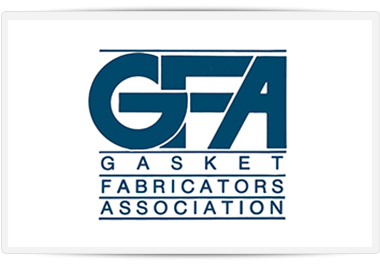While they are low cost and appear to be simple, the value of choosing the best gasket material — such as expanded ptfe, vegetable fiber, or flexible graphite —cannot be understated. Even so, the custom gasket material is often not reviewed until there is gasket failure or if there is a high maintenance cost associated with servicing the gasket.
In either case, the primary function of a custom gasket is to provide mechanical seals for a liquid or gas throughout the life of the application. The industrial gasket serves as a buffer and compensates for any imperfections between mating surfaces that need to be sealed.
Let's take a closer look at a few elements that should be addressed in choosing the best gasket material for mechanical seals and other applications.
Temperature Considerations for Gasket Materials
The starting point for choosing the best gasket material is typically temperature. Temperature considerations are critical because it can alter the physical characteristics of a material, including compression set, sealing properties, and maximum allowable stress.
It's vital to consider both external and internal temperatures because gaskets in direct sunlight exposure can easily experience internal temperatures in excess of 140 degrees.
On the other hand, exposure to an extremely cold flow or freezing temperatures can cause gaskets to become brittle or stiff, which can alter their physical properties and increase the chances of it failing.
Gaskets that experience cycling from warm to cold or vice versa in extreme applications can exhibit a higher compression set. As you can see, considering the temperature range is critical in choosing the best gaskets. It's imperative the material selected for gaskets can withstand exposure to the necessary range of temperatures.
UV & Ozone Considerations for Gasket Material
Ozone and UV exposure are both potential sources of rubber gasket degradation. It's also important to understand ozone doesn't just come from the atmosphere, but it can be created by electrical enclosures with high voltage electrical components.
In either case, ozone and UV will break down the carbon bonds in the backbone polymers, which can result in hardening, drying, flaking, cracking, and scaling. Organic rubber gaskets like natural rubber, Buna-N (Nitrile), Buna-S(SBR), and synthetic isoprene will break down relatively quickly in exposure. However, EPDM and silicone are two materials that may be better equipped to resist UV in different applications.
Pressure Considerations for Gasket Materials
When a certain amount of pressure is exerted on a system, joints can begin to deform. As a result, it's vital for pressure to be considered when choosing the best gasket materials. Today, some of the gaskets have a P x T rating factor offering insight into the max limits of pressure and temperature combined.
Electromagnetic Interference (EMI) Considerations for Gasket Materials
Manufacturers of aerospace, automotive, consumer, and industrial electronics are required to meet Federal (EMI) product standards. EMI is emitted by components as well as internal wires and can function like emitting antennas.
For EMI radiation to be controlled, electronic components must be completely encased in a conductive enclosure, and it's vital the enclosure and lid have complete contact.
As a result, a viable conductive gasket is necessary. In addition to EMI attenuation, these gaskets may also function as environmental sealing.
Media Considerations for Gasket Materials
Undoubtedly, the media the gasket will be exposed to is a critical consideration. In general, gas will be more difficult to seal than a liquid. After the material with an acceptable temperature/pressure range has been identified, the next step is to consider whether it will be compatible with the media being sealed.
Chemicals can impact the functional properties and structural integrity of the material. And the chemical resistance of the gasket material is critical because the other properties of the gasket material would be irrelevant.
You should also consider the effect temperature will have on its chemical resistance. For instance, many fluids can be more aggressive in certain temperatures. As a result, gaskets used to seal fluids at an ambient temperature may not perform the same at higher temperatures.
Common Gasket Materials & Key Characteristics
Now we've covered a few of the top considerations for choosing the best gasket materials, let's look at a few common materials and their characteristics. At Frank Lowe, we offer most of our gasket materials on a roll or on a sheet based on the unique needs of your application.
Non-Asbestos Types of Gaskets
Non-asbestos types of gaskets are created from a compressed fiber material and a binding elastomer. Non-asbestos types of gaskets are used across many different applications, involving water, oil, acid, and steam.
Cork Gasket Materials
Cork gasket materials are very stable, lightweight materials with the ability to resist water penetration.
Key Benefits of Cork Material for Gaskets
It boasts outstanding compressibility, high resistance to oil, solvents, and no lateral flow. Cork is unaffected by extreme temperatures and is resistant to wear. At Frank Lowe, we offer cork materials on a sheet as well as on rolls.
Cork-n-Rubber Gasket Materials
Cork-n-rubber materials are a combination of synthetic rubber polymers and granulated cork.
Key Benefits of Cork-n-Rubber Materials
This offers high flexibility and resilience of rubber with the compressibility of cork. In addition, the rubber boasts the ability to provide chemical compatibility and act as a seal while helping resist weather conditions, acids, and fungus.
You can choose from a range of different rubber materials to best meet the chemical resistance needs of the gasket. You can also opt for cork-n-rubber die cut on a sheet or on a roll based on your needs.
Silicone Gasket Materials
Silicone gaskets are offered as foam, sponge, or as a solid. In either case, the characteristics can include general inertness, high-temperature stability, and resilience.
Key Benefits of Silicone Gasket Material
Silicone offers a number of benefits, including:
However, silicone is not suitable for many hydrocarbons and steam.
Natural Rubber Gasket Materials for Mechanical Seals
Natural rubber is commonly used for its outstanding recovery properties. It offers excellent resistance to mild acids, most inorganic salts, and alkalis. However, natural rubber isn't suitable for solvent fluid and oils or in prominent exposure to oxygen, ozone, or sunlight.
Urethane Gasket Material
Urethanes offer good abrasion and aging characteristics but aren't ideal for high temperatures.
Key Benefits of Urethane Gasket Material
In addition, urethane boasts:
Neoprene Gasket Materials
Neoprene gaskets will have good tear strength, resistance to ozone and UV, and strong resilience. However, neoprene used in different applications, such as for a seal or full-face gaskets, can be easily damaged by petroleum-based fuels.
Key Benefits of Neoprene Gasket Material
A few key benefits of gaskets made from neoprene include:
EPDM Gasket Materials
As a closed-cell sponge rubber material, EPDM seals offer good compressibility, aging properties, and resistance to oxidation as well as ozone. At the same time, EPDM seals are waterproof and can withstand high temperatures.
Contact Frank Lowe for the Best Custom Gaskets, Seals & Gasket Materials
Whether you already know the best mechanical gasket material and are ready for production or would like a qualified second opinion, the experts at Frank Lowe can help. We offer a full line of elastomers — including nitrile, neoprene, natural rubber, and more — and can meet all mil-spec requirements.
With a customer-first approach, we will always listen to your unique application needs and specifications to guide you to the best material for your gaskets. We also offer a full range of adhesives designed to bond with virtually all surfaces. In the end, our goal is to cover all the details, so your mechanical gasket or seal performs as intended.
Contact Frank Lowe today.






